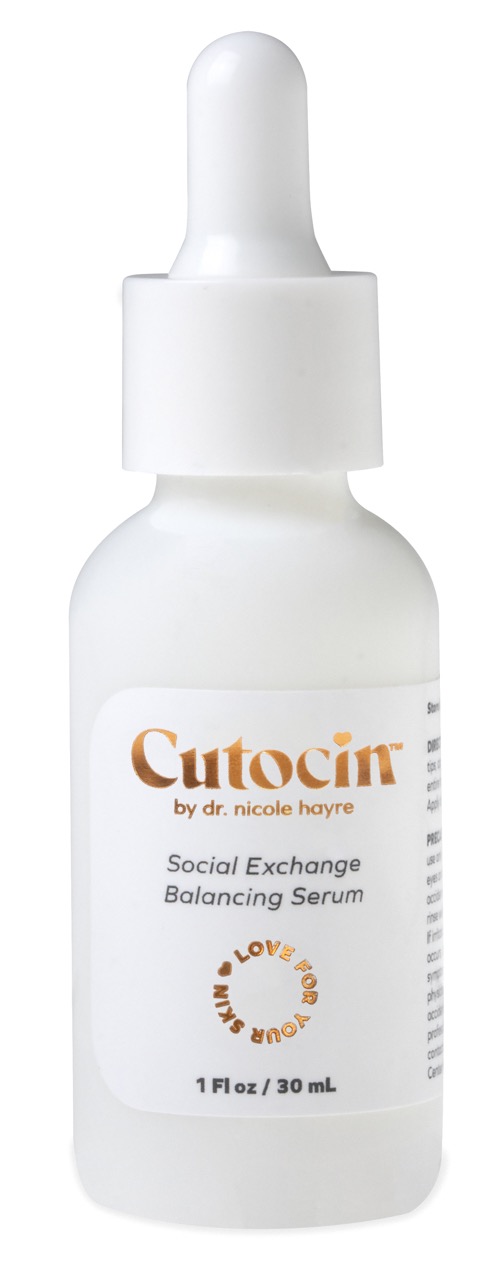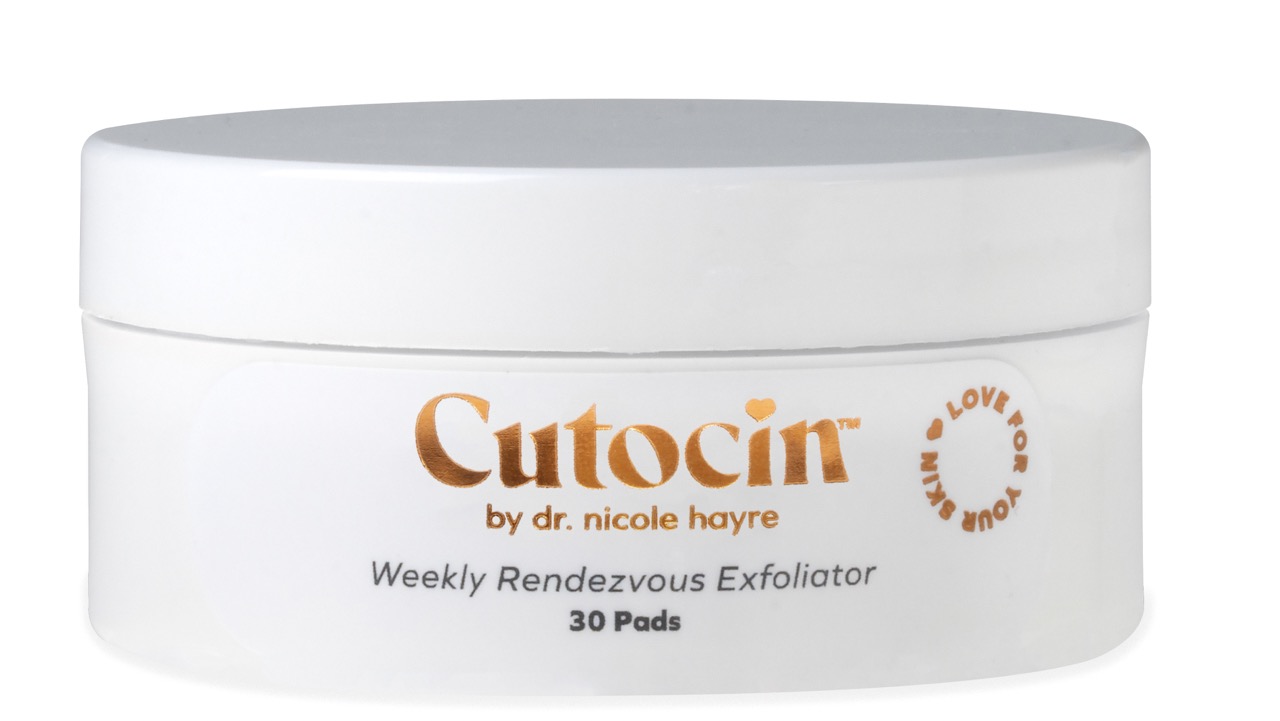This Anti-Inflammatory Skin-Care Line Is Designed To Mimic the Glow of Falling In Love
Our skin glows when we're in love. That's thanks to oxytocin, also known as "the love hormone," which our bodies release in response to a loving touch. Sure, this can happen during sex, but also when we hug a loved one or feel a welcomed caress. The effect of oxytocin on our skin is so strong, that board-certified dermatologist Nicole Hayre, MD, can immediately tell when one of her patients is in a new relationship or experiencing heartbreak.
"I get to know my patients really well and sometimes throughout their visits, all of a sudden someone will come in and they look different," says Dr. Hayre. "It could be that they look great all of a sudden or that their skin looks completely depleted, just drained of life and wiped out. That's happened several times over the 20 years I've practiced where I'm like, 'Oh, something's wrong.' And it's not the expression on their face. It's not something that they said, and it's just how their skin looks. And then I get to talking to them and I find out what happened."
The science behind the oxytocin glow
She realized this change was the result of oxytocin. It's primarily produced in the hypothalamus of the brain, but it's also produced in other parts of the body including the keratinocytes of the epidermal layer of the skin. Translation: Your skin makes oxytocin. The hormone also binds to receptors in the skin.
"When it does that, it turns off a destructive pathway that's usually on called the senescence-associated secretory phenotype," aka SASP, says Dr. Hayre. "And this phenotype usually spits out these cytokines that are inflammatory and destructive. And so when oxytocin is present, it shuts that off and gives skin time to rejuvenate and to be healthier."
{{post.sponsorText}}
She combed through research and found that oxytocin has benefits throughout the body (in the gastrointestinal tract, pulmonary system, etc.) "In general, oxytocin is making you healthier," says Dr. Hayre. And she confirmed the role it plays in skin health with a small study in her office. Six women collected urine samples over a 24-hour period so Dr. Hayre could measure their oxytocin levels. Then, she used a standardized photography system and a rating scale to determine how the women's skin looked in relation to their age.
"What I found was there was a linear correlation—the higher the oxytocin, the better they looked for their age," says Dr. Hayre. "And this was in spite of sun exposure because the woman in my study who had the most sun exposure actually had the highest oxytocin level and looked the best for her age."
Dr. Hayre realized that this connection between being socially and physically healthy and having more radian skin is indeed a system. "I coined it the 'oxytocin social-exchange system,'" she says. She shared her research with her patients and was blown away by the response. "We all joke about 'the glow' and all of that, but no one's really proven it before or shown scientific evidence for it. And, honestly, some of the women who really get excited about this are the ones who've had a loss, for instance, were left in the lurch and they were just devastated and drained. Now they feel validated, like 'Yes, he took this away from me. Look what he did to me—I knew it."
Bottling the magic
Based on her research, Dr. Hayre figured out a way to harness the impact oxytocin has on our skin and literally bottle it up. She identified a botanical that has been used in medicine for centuries to mimic oxytocin's ability to turn off inflammatory SASP and is using it as the secret ingredient across all the products in her new brand, Cutocin.
"Because of Food and Drug Association (FDA) regulations, I cannot say for sure that it's shutting off SASP the way that oxytocin does" and getting FDA-approval costs millions, says Dr. Hayre. "But we can say that we are seeing a similar effect, in that skin is behaving as if oxytocin is by rejuvenating really quickly."
So far, Cutocin has three products and they all include the patent-pending botanical. The Social Exchange Balancing Cream ($159), the Social Exchange Balancing Serum ($159), and the Weekly Rendezvous Exfoliator ($130).

This cream is the first Cutocin product Dr. Hayre created. “The cream is fully loaded—it has your antioxidants, your peptides, a gentle form of retinoic acid. And we put in the patent-pending ingredient and it’s like the secret sauce that was missing all along,” she says. “I’ve sold these all-in-one fully loaded creams in my office for years, and they’re good, but I’ve never seen skin turn around so fast before the way it has with Cutocin. And I’ve never seen the response of the buyers, the patients, the way I have with this. I’ve been selling it out of the office for a couple of years and there were a couple of times, especially post-COVID with supply chain issues that we ran out and people would panic—and I’ve never seen that before with any of the products that I sold.”

Next up was this serum. Dr. Hayre designed it to be used in the morning and then to use the cream at night. But if you have sensitive skin and can’t use the cream because of the retinoic acid, she says you can instead use the serum day and night. “The serum also has the patent-pending ingredient, azelaic acid, and antioxidants. Plus, it has a beautiful finish,” she says. Azelaic acid reduces inflammation and evens skin tone while the antioxidant niacinamide boosts skin hydration while brightening. The formula also includes sodium hyaluronate (a form of hyaluronic acid) to hydrate and peptides to revitalize and improve elasticity.

“We came out with the Weekly Rendezvous pads to give your skin a little extra something,” says Dr. Hayre. “They exfoliate with a really nice gentle formulation of mandalic acid, azelaic acid, and salicylic acid,” and of course, the oxytocin-mimicking botanical, she says. “You wipe the pad over your skin and leave the solution on for five, 10 minutes, or longer, and then rinse off. Do that once a week and you’re nice and smooth and your skin-care products penetrate better.”
Expect to see a sunblock, "because I'm a dermatologist and I love the sunblock," and a cleanser that harnesses this same technology coming from Cutocin soon. In the meantime, you can use any of the above self-love potions to give your skin that oxytocin glow all by yourself.
Loading More Posts...